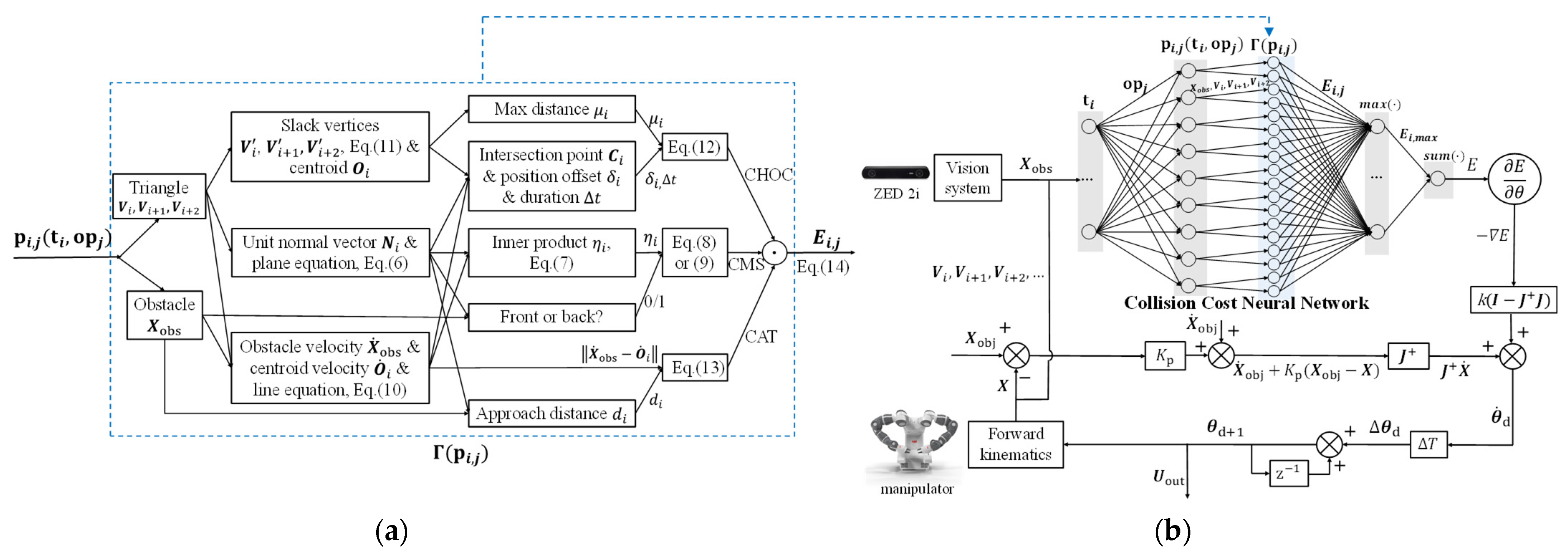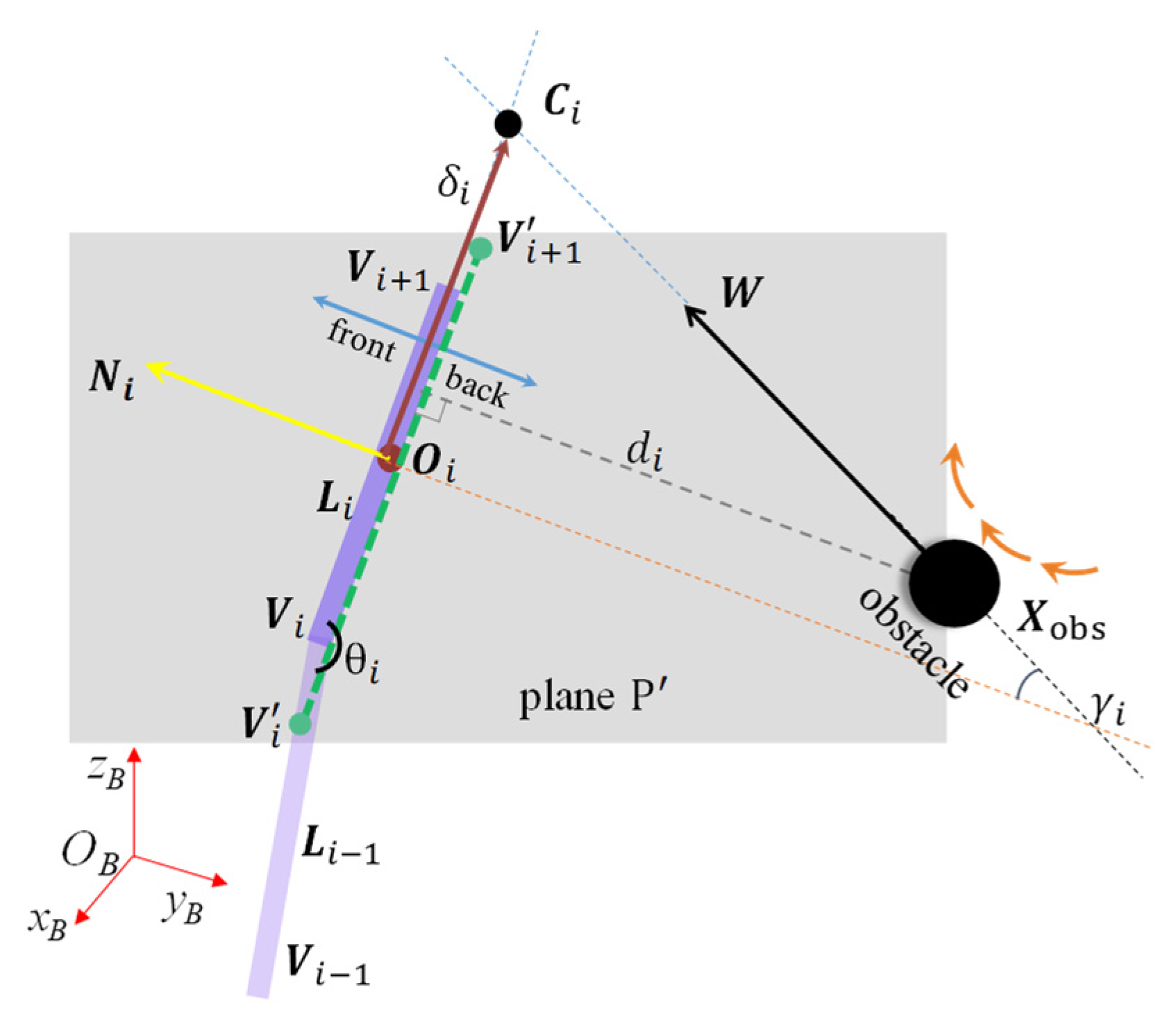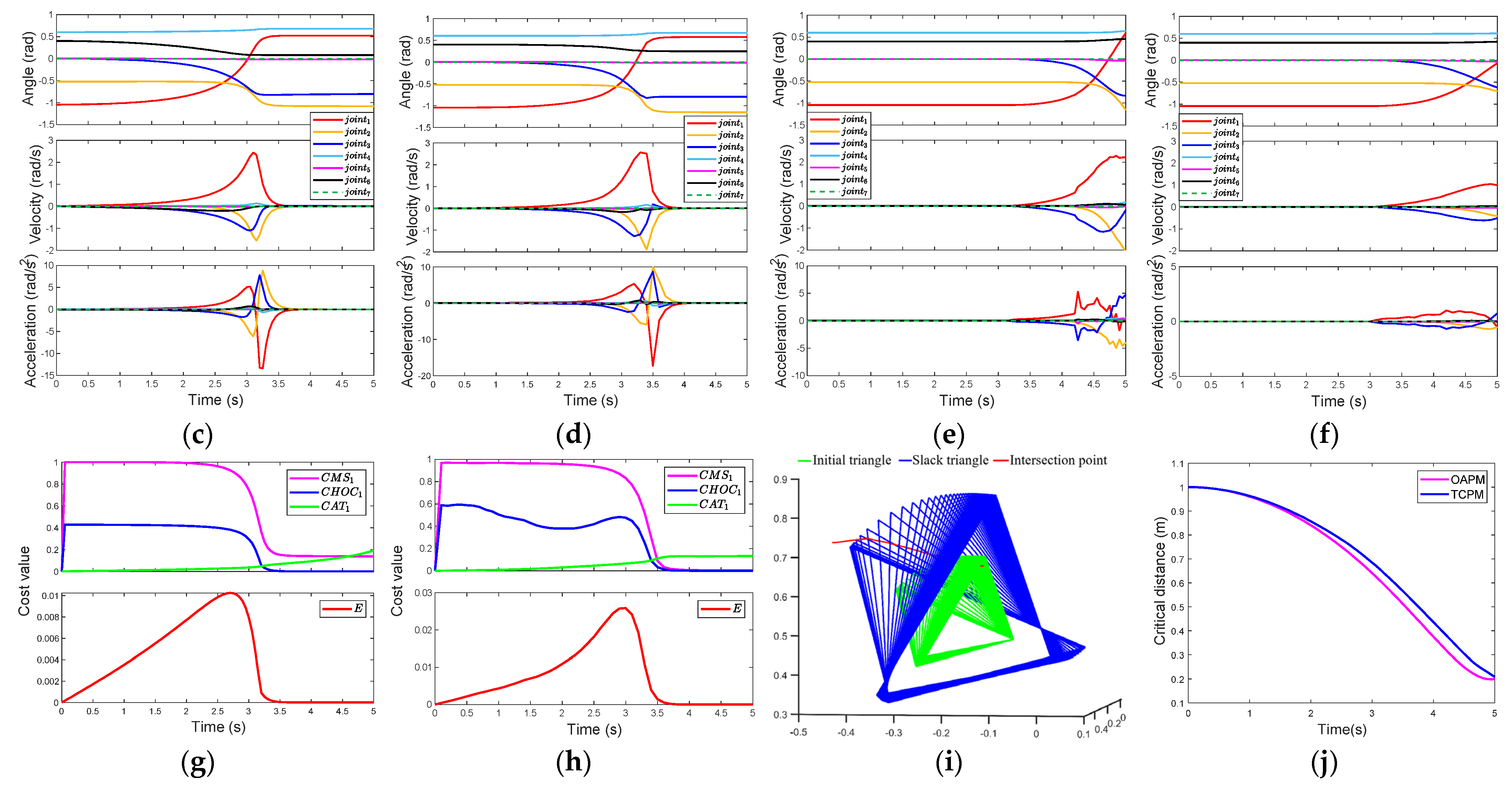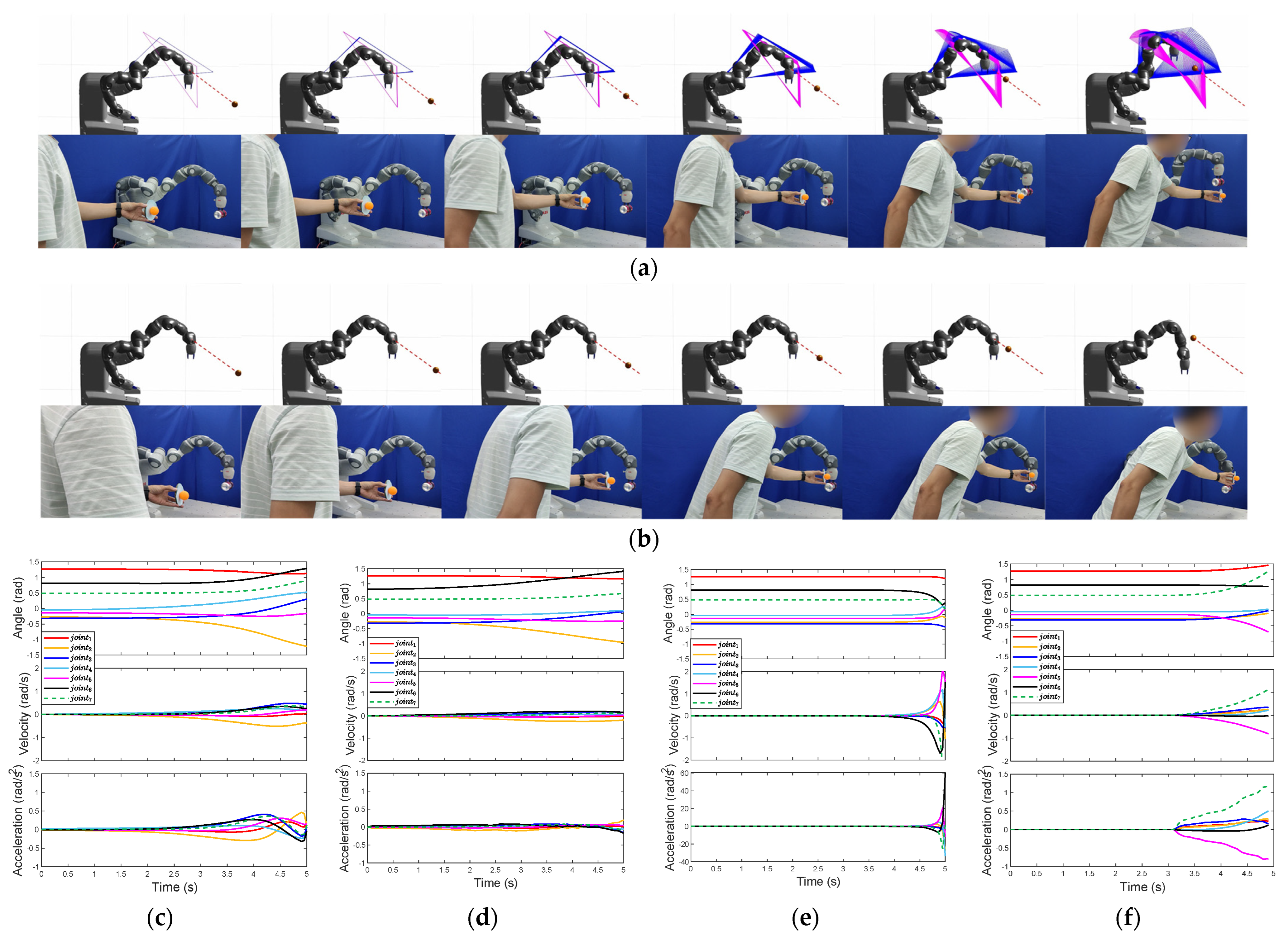A Predictable Obstacle Avoidance Model Based on Geometric Configuration of Redundant Manipulators for Motion Planning
Abstract
1. Introduction
2. Problem Formulation
3. Obstacle Avoidance Method Design
3.1. Predictable Obstacle Avoidance Model
3.2. Modeling Strategy for Singularity
- (1)
- The obstacle is nearly moving on plane in Figure 2; that is, is close to 0, and the obstacle is in parallel state.
- (2)
- The two adjacent links are close to collinear; that is, is close to 180°. In this case, the triangular collision plane cannot be formed.
4. Simulation and Experiment
4.1. One-Triangle Case
4.2. Two-Triangle Case
5. Conclusions
Author Contributions
Funding
Data Availability Statement
Conflicts of Interest
References
- Haddadin, S.; Luca, A.D.; Albu-Schaffer, A. Robot Collisions: A Survey on Detection, Isolation, and Identification. IEEE Trans. Robot. 2017, 33, 21. [Google Scholar] [CrossRef]
- Cortés, J.; Siméon, T. Sampling-Based Motion Planning under Kinematic Loop-Closure Constraints. In Algorithmic Foundations of Robotics VI; Erdmann, M., Overmars, M., Hsu, D., van der Stappen, F., Eds.; Springer: Berlin/Heidelberg, Germany, 2005; Volume 17, pp. 75–90. [Google Scholar]
- Ghajari, M.F.; Mayorga, R.V. Specialized PRM Trajectory Planning For Hyper-Redundant Robot Manipulators. WSEAS Trans. Syst. 2017, 16, 7. [Google Scholar]
- Stilman, M. Task constrained motion planning in robot joint space. In Proceedings of the 2007 IEEE/RSJ International Conference on Intelligent Robots and Systems, San Diego, CA, USA, 29 October–2 November 2007; pp. 3074–3081. [Google Scholar]
- Hua, X.; Wang, G.; Xu, J.; Chen, K. Reinforcement learning-based collision-free path planner for redundant robot in narrow duct. J. Intell. Manuf. 2020, 32, 471–482. [Google Scholar] [CrossRef]
- Maciejewski, A.A.; Klein, C.A. Obstacle Avoidance for Kinematically Redundant Manipulators in Dynamically Varying Environments. Int. J. Robot. Res. 1985, 4, 109–117. [Google Scholar] [CrossRef]
- Petrič, T.; Gams, A.; Likar, N.; Žlajpah, L. Obstacle Avoidance with Industrial Robots. In Motion and Operation Planning of Robotic Systems; Carbone, G., Gomez-Bravo, F., Eds.; Springer International Publishing: Cham, Switzerland, 2015; Volume 29, pp. 113–145. [Google Scholar]
- Zhang, H.; Jin, H.; Liu, Z.; Liu, Y.; Zhu, Y.; Zhao, J. Real-Time Kinematic Control for Redundant Manipulators in a Time-Varying Environment: Multiple-Dynamic Obstacle Avoidance and Fast Tracking of a Moving Object. IEEE Trans. Ind. Inf. 2019, 16, 28–41. [Google Scholar] [CrossRef]
- Ericson, C. Real-time collision detection. In The Morgan Kaufmann Series in Interactive 3D Technology; Eberly, D.H., Ed.; Morgan Kaufmann Publishers: Burlington, VT, USA, 2005. [Google Scholar]
- Ratliff, N.; Zucker, M.; Bagnell, J.A.; Srinivasa, S. CHOMP: Gradient optimization techniques for efficient motion planning. In Proceedings of the 2009 IEEE International Conference on Robotics and Automation, Kobe, Japan, 12–17 May 2009; pp. 489–494. [Google Scholar]
- Kalakrishnan, M.; Chitta, S.; Theodorou, E.; Pastor, P.; Schaal, S. STOMP: Stochastic trajectory optimization for motion planning. In Proceedings of the 2011 IEEE International Conference on Robotics and Automation, Shanghai, China, 9–13 May 2011; pp. 4569–4574. [Google Scholar]
- Park, C.; Pan, J.; Manocha, D. ITOMP: Incremental trajectory optimization for real-time replanning in dynamic environments. In Proceedings of the International Conference on Automated Planning and Scheduling (ICAPS), Sao Paulo, Brazil, 25–29 June 2012; pp. 207–215. [Google Scholar]
- Schulman, J.; Ho, J.; Lee, A.; Awwal, I.; Bradlow, H.; Abbeel, P. Finding locally optimal, collision-free trajectories with sequential convex optimization. In Proceedings of the Robotics: Science and systems (RSS), Berlin, Germany, 24–28 June 2013; Volume 9, pp. 1–10. [Google Scholar]
- Escande, A.; Miossec, S.; Kheddar, A. Continuous gradient proximity distance for humanoids free-collision optimized-postures. In Proceedings of the 2007 7th IEEE-RAS International Conference on Humanoid Robots, Pittsburgh, PA, USA, 29 November–1 December 2007; pp. 188–195. [Google Scholar]
- Salehian, S.S.M.; Figueroa, N.; Billard, A. A unified framework for coordinated multi-arm motion planning. Int. J. Robot. Res. 2018, 37, 1205–1232. [Google Scholar] [CrossRef]
- Nie, J.; Wang, Y.; Mo, Y.; Miao, Z.; Jiang, Y.; Zhong, H.; Lin, J. An HQP-Based Obstacle Avoidance Control Scheme for Redundant Mobile Manipulators Under Multiple Constraints. IEEE Trans. Electron. 2023, 70, 6004–6016. [Google Scholar] [CrossRef]
- Khan, A.H.; Li, S.; Luo, X. Obstacle Avoidance and Tracking Control of Redundant Robotic Manipulator: An RNN-Based Metaheuristic Approach. IEEE Trans. Ind. Inf. 2019, 16, 4670–4680. [Google Scholar] [CrossRef]
- van den Berg, J.; Guy, S.J.; Lin, M.; Manocha, D. Reciprocal n-Body Collision Avoidance. In Robotics Research; Pradalier, C., Siegwart, R., Hirzinger, G., Eds.; Springer: Berlin/Heidelberg, Germany, 2011; Volume 70, pp. 3–19. [Google Scholar]
- Choi, M.; Rubenecia, A.; Shon, T.; Choi, H.H. Velocity Obstacle Based 3D Collision Avoidance Scheme for Low-Cost Micro UAVs. Sustainability 2017, 9, 1174. [Google Scholar] [CrossRef]
- Han, R.; Chen, S.; Wang, S.; Zhang, Z.; Gao, R.; Hao, Q.; Pan, J. Reinforcement Learned Distributed Multi-Robot Navigation With Reciprocal Velocity Obstacle Shaped Rewards. IEEE Robot. Autom. Lett. 2022, 7, 5896–5903. [Google Scholar] [CrossRef]
- Zhao, L.; Zhao, J.; Liu, H. Solving the Inverse Kinematics Problem of Multiple Redundant Manipulators with Collision Avoidance in Dynamic Environments. J. Intell. Robot. Syst. 2021, 101, 30. [Google Scholar] [CrossRef]
- Hoffmann, H.; Pastor, P.; Park, D.-H.; Schaal, S. Biologically-inspired dynamical systems for movement generation: Automatic real-time goal adaptation and obstacle avoidance. In Proceedings of the 2009 IEEE International Conference on Robotics and Automation, Kobe, Japan, 12–17 May 2009; pp. 2587–2592. [Google Scholar]
- Wampler, C.W. Manipulator Inverse Kinematic Solutions Based on Vector Formulations and Damped Least-Squares Methods. IEEE Trans. Syst. Man Cybern. 1986, 16, 93–101. [Google Scholar] [CrossRef]








| Parameters | k | |||||||||||
|---|---|---|---|---|---|---|---|---|---|---|---|---|
| Value | 10 | 1 | 1 | 1 | 2.0 | 0.03 m/s | 1.0 | 0.8 m | 0.6 m | 0.05 s | 0.1 s | 10 |
Disclaimer/Publisher’s Note: The statements, opinions and data contained in all publications are solely those of the individual author(s) and contributor(s) and not of MDPI and/or the editor(s). MDPI and/or the editor(s) disclaim responsibility for any injury to people or property resulting from any ideas, methods, instructions or products referred to in the content. |
© 2023 by the authors. Licensee MDPI, Basel, Switzerland. This article is an open access article distributed under the terms and conditions of the Creative Commons Attribution (CC BY) license (https://creativecommons.org/licenses/by/4.0/).
Share and Cite
Ju, F.; Jin, H.; Wang, B.; Zhao, J. A Predictable Obstacle Avoidance Model Based on Geometric Configuration of Redundant Manipulators for Motion Planning. Sensors 2023, 23, 4642. https://doi.org/10.3390/s23104642
Ju F, Jin H, Wang B, Zhao J. A Predictable Obstacle Avoidance Model Based on Geometric Configuration of Redundant Manipulators for Motion Planning. Sensors. 2023; 23(10):4642. https://doi.org/10.3390/s23104642
Chicago/Turabian StyleJu, Fengjia, Hongzhe Jin, Binluan Wang, and Jie Zhao. 2023. "A Predictable Obstacle Avoidance Model Based on Geometric Configuration of Redundant Manipulators for Motion Planning" Sensors 23, no. 10: 4642. https://doi.org/10.3390/s23104642
APA StyleJu, F., Jin, H., Wang, B., & Zhao, J. (2023). A Predictable Obstacle Avoidance Model Based on Geometric Configuration of Redundant Manipulators for Motion Planning. Sensors, 23(10), 4642. https://doi.org/10.3390/s23104642







